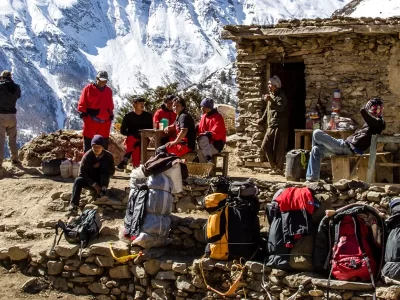Teahouse Trekking in Nepal: All You Need To Know
The majority of treks in Nepal are “teahouse treks,” meaning that each night you wind up at a straightforward lodge with straightforward rooms and a meal. The nicest part of teahouse hiking is that you only need to bring a very small amount of equipment. (below picture)
When you trek “teahouse style,” you spend each night in a lodge. The majority of the primary trekking routes in Nepal are teahouse treks, allowing trekkers to pack as little kit as possible.
A teahouse can be anything from a huge, well-built lodge with common rooms that is comfortable and well-built (like those in the SoluKhumbu) to a little bamboo hut that is tucked inside a forest on a high slope.
What The majority of teahouses are simple stone and timber structures or huts with a kitchen, a communal dining room, a restroom, and a number of simple bedrooms with typically two single beds and a table. Teahouses differ slightly from region to region. The majority of teahouses in Nepal are designed primarily for trekkers, however in some of the more outlying areas, some may also serve as the family’s residence.is a Teahouse?
Expect the accommodations to be straightforward but tidy, and budget a little bit more for an attached bathroom. A thick blanket will be provided in your room, which you can use as your main blanket for the night or as a second layer over your sleeping bag if it’s cold outside. The majority of hikers forego taking showers while on their hike, but some teahouses do provide hot bucket showers for a modest price.
Insider advice: If you’re concerned about hygiene, carry a light sleeping sack or bed liner from home or buy one in Pokhara or Kathmandu. Given that most teahouses have quite thin walls, it is always a good idea to pack some earplugs.)
Teahouse Etiquette
Everything at your teahouse, with the exception of personal snacks and drinks, which you typically pay for yourself, will be taken care of if your lodging and meals are included as part of a package trek. Almost always, the price of your accommodation is very reasonable (about $5/night), and the proprietors primarily rely on sales of food and beverages to support their operations. Due to this, you must consume all of your meals at the teahouse where you are staying.
Meals at Your Teahouse
Nearly all of the teahouses provide a similar set menu that includes dhal bhat, momos, pasta, pizza, and other rice and noodle meals. It’s essential to check in advance to see what’s fresh and accessible because some meals (like momos) take longer to prepare than others. It’s a good idea to order whatever is in season to avoid getting sick while hiking. The majority of trekkers, tour operators, and porters choose dhal bhat since it is typically reliable, healthful, and widely accessible wherever you go.
Generally speaking, the higher you go on your trek, the more expensive meals will continue to be. For instance, expect to pay more for dhal bhat in GorakShep (high in the mountains, near to Everest Basecamp) than you would in Lukla (easily accessible due to its airport and lower height).
Wi-Fi & Electricity
Nowadays, the dining halls of many teahouses in Nepal contain charging stations and wifi. However, due to outdated routers, connection availability and speed are at best sporadic and become slower the more users who are connected. Better internet access can be found in teahouses in the SoluKhumbu (particularly in Namche Bazaar), but don’t hold your breath for much elsewhere in Nepal.
You can typically spend $2.50 (Rs. 250) at teahouses to charge your electronics. However, power interruptions are rather common, so make sure to charge when you can!
Recent Blog Posts

- September 23, 2023

- September 22, 2023

- September 22, 2023

